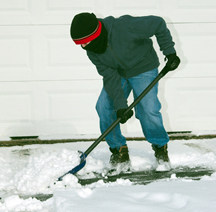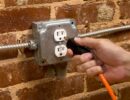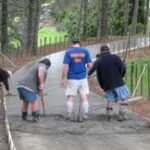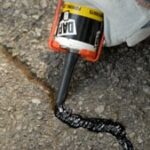Advice for how to clear snow from driveways and outdoor pathways, including choosing the right snow shovel, spreading salt, and helpful and safety tips.
In cold climates, shoveling snow is an important yet potentially dangerous job. Hospitals are often inundated with patients suffering from everything from pulled muscles to heart attacks following a snowstorm. Here’s how to shovel snow safely and efficiently.
1Make sure you are up to the task. If you are out of shape or have heart or back problems or other physical or health limitations, get approval from your doctor before tackling this job yourself. If you’d like to pass on the task, hire a local student to do it for you, or borrow a snow blower from a neighbor.
2Get yourself a good snow shovel. An ideal shovel is lightweight, with a non-stick surface, long handle and wide, open ends that allow snow to be quickly tossed to the side as you work.
3Make a plan, and decide where you are going to deposit the snow as you shovel. Make sure you’re not putting it in a place where you’ll have to move it again.
4Begin shoveling, using a deliberate, steady motion. Focus on clearing snow from areas of regular foot traffic. This includes walkways and steps between your house and the street, driveway, car, mailbox, garbage cans, etc. Shovel snow from the driveway, making sure there’s plenty of space for clear passage for your car to drive in and out. Often the best way to clear a driveway is by “pushing” the snow. This is done by holding the shovel at a slight angle, and pushing forward in passes back and forth across the width of your driveway, piling up the snow at its edges.
5After you’ve cleared as much loose snow as you can, chip away patches of ice with the edges of the shovel. You may need a hammer or pick-axe if it’s especially thick or difficult to remove.
6Spread a good amount of rock salt or halite across the area you’ve just cleared. This will prevent new ice from building up too quickly. However, use salt with caution around your lawn or landscaping, as it can be damaging to plants. You will only want to use salt if the temperature is warm enough to allow the ice to melt. If any slippery patches remain, spread a little sand around, but use sand with caution as well; It’s helpful temporarily, but can create a mess as the ice melts and re-freezes. It’s also very difficult to remove once it’s re-frozen.
TIPS:
* Shovel your snow before it builds up too much. Its own weight can cause the bottom layers to compress and turn to ice, making it much harder to remove.
* As you shovel snow, it is easy to get tired quickly. Work toward the area where you are putting the snow so you have a closer haul toward the end of the task.
* Dress warmly, wearing layers. This allows you to peel off clothing if you get overheated. Wear gloves or mittens.
* Don’t be in a hurry. Let yourself take frequent breaks. Stretch and drink plenty of water. You can still get very dehydrated even in cold weather.
* Remove as much slush and water from the ground as you can, using a shovel and a broom. It can re-freeze overnight and become a difficult-to-remove hazard by the next day.
* When you’re done, warm yourself up with a cup of hot chocolate!
–GV








 Don Vandervort writes or edits every article at HomeTips. Don has:
Don Vandervort writes or edits every article at HomeTips. Don has:



